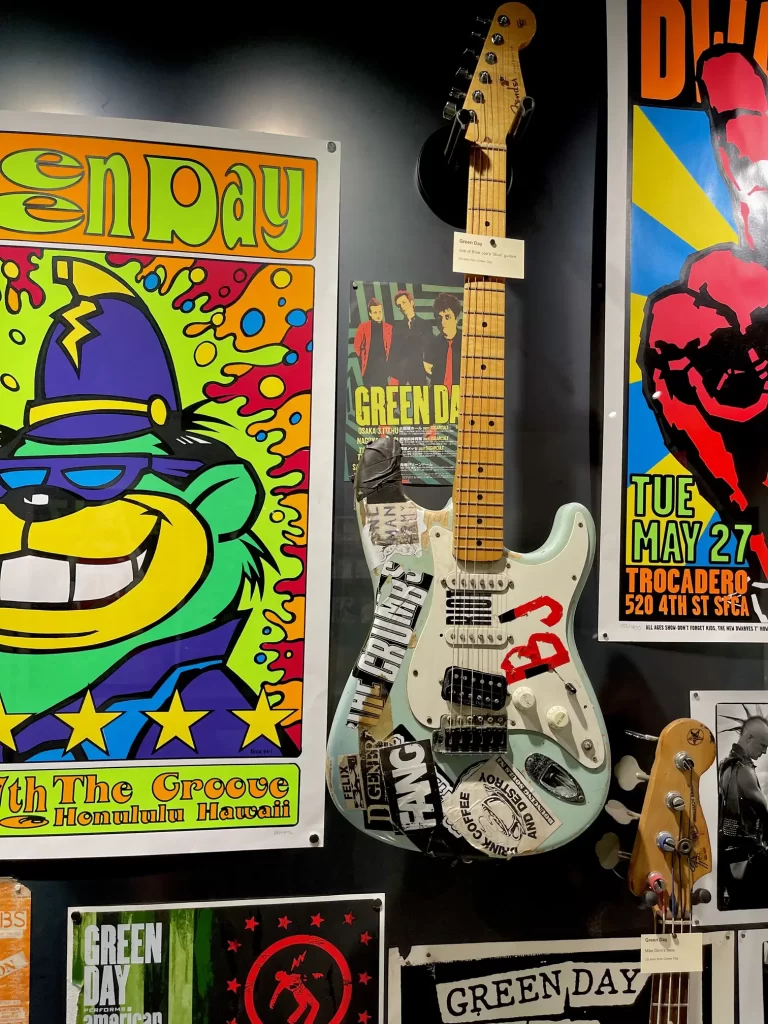
The Punk Rock Museum in Las Vegas Reminds Us to Stand Up, Speak Out, and Fight For What’s Right

The music industry may not have room for punk rock, but Las Vegas is certainly doing everything it can to ensure that it does by means of The Punk Rock Museum, the world’s first-ever museum dedicated entirely to the history of punk rock and emo culture.
While it may not seem obvious, much of today’s music culture has been inspired by the era of punk rock, giving rise to many of today’s most popular bands, including, but not limited to Green Day, Blink-182, Sum41, Foo Fighters, Dead Kennedys, Bayside, Sex Pistols, The Used, and so many more.
What Does “Punk” Really Mean?
The birthplace of punk rock is believed to have begun in the UK in the late 1960s and into the late 1970s – however, many argue that it actually started in New York, with iconic venues such as CBGB in Manhattan.
What we normally refer to as “punk,” simply refers to an artistic and musical movement that was all about empowering anti-establishment leanings and sticking it to “the man.”
Heavily politicized, this nihilist expression was heavily influenced by garage rock in the late 1960s, transcending beyond the boundaries of socioeconomic restrictions and challenging societal norms that fought against government corruption, injustice, unfairness through short, fast-paced lyrics with hard-edged vocals and melodies.
In other words, if you were young and had something on your mind – why shouldn’t you express it through your anger, rage, frustration, and complete vulnerability?
“The [punk rock] culture is more than just the music. It’s the DIY ethos. It’s about giving back to your community, charity work, and supporting the people that need help,” said Mona Whetzel, the Museum’s Artifact Acquisitions & Collections Manager at The Punk Rock Museum in an interview with Luxe Beat Magazine.
Opening The Punk Rock Museum
Almost 50 years later, punk rock culture still exists and continues to impact today’s boomers and younger generations.
What started as an initial punk-retail shop during the COVID-19 pandemic, quickly became a 12,000 square-foot museum concept from NOFX’s “Fat Mike,” dedicated to the history and culture of punk rock and emo, which officially opened this past April.
The rest of the founding team includes co-founder Warped Tour manager Lisa Brownlee, rock photographer Lisa Johnson, Less Than Jake’s former drummer Vinnie Fiorello, the Museum’s Artifact Acquisitions & Collections Manager Mona Whetzel and Melanie Kaye, Director of Publicity and Promotions – in addition to some of its more notable investors such as professional skateboarder Tony Hawk and Foo Fighters guitarist Pat Smear.

Guitar from Green Day’s Billie Joe Armstrong | Credit: Lisa Johnson
With approximately 3,000 to 4,000 artifacts, The Punk Rock Museum comprises collections, which the majority of have been loaned and/or donated by the bands and people who helped create, shape, and expand punk rock culture.
But it is so much more than a museum. It’s a step into a judgment-free world with the artists and bands we grew up listening to (thanks to our parents), a bar, a tattoo parlor, a wedding chapel, a punk shop, and more.
After an exhausting, but unforgettable weekend at last month’s When We Were Young Festival 2023 weekend in Las Vegas, Luxe Beat Magazine’s last stop in Sin City was paying a visit to The Punk Rock Museum, where bassist Nick Ghanbarian of Bayside gave our collective group a one-hour guided tour of the Museum.
From NOFX, Pennywise, and Sex Pistols to Green Day, Sum41, Bayside, and Rise Against, words cannot do The Punk Rock Museum justice in terms of the blood, sweat, and tears that make up the museum’s capture of these groundbreaking bands and the legacy they’ve left (and continue to leave behind).
Whether it was getting to see the “small, too tiny-to-wear” clothing these bands and artists would somehow manage to practice and perform in or the handwritten lyrics, musical instruments, volumes of photos, band flyers, or life-size artwork, I undeniably walked away from The Punk Rock Museum with a small taste of what this era was really all about.
Preserving Punk Rock History

(L-R): Melanie Kaye, Director of Publicity and Promotions, Mona Whetzel, the Museum’s Artifact Acquisitions & Collections Manager
After the guided tour, Luxe Beat sat down on-site with Mona Whetzel, the Museum’s Artifact Acquisitions & Collections Manager and Melanie Kaye, Director of Publicity and Promotions, to learn more about how The Punk Rock Museum’s exhibit was structured, including the “door-to-door” efforts in collecting these historical artifacts.
Whetzel, who found her tribe in the punk community as a teenager, wanted to give back through the museum. Referring to the team initially as a “collective,” she told Luxe Beat that the concept came to life during the COVID-19 pandemic, which consisted of “a bunch of Zoom calls.”
From the building’s purchase and subsequent construction, the team then turned all of its attention towards collecting artifacts and how the exhibit would be laid out.
“All of us went through our collective rolodexes and started reaching out to people to get everything we needed to fill up the museum. We landed on doing a timeline starting with proto-Punk in the late 60s, early 70s – and doing it semi-geographically,” Whetzel recalled.
Kaye shared with Luxe Beat Magazine that her journey into punk began in Ottawa when she was around 14-15 years-old. To see the bands she wanted, she started booking them herself, learning the inner-workings of artist management.
“I think one of the things that we all share in our collective are values that we incorporate into the museum as well as how we roll in our lives,” she added. Since 1999, Kaye has been running Fat Wreck Chords Canada, while in continuing to work with long-time clients Jello Biafra, No Means No, and The Hanson Brothers, and launching her own public relations company, Melanie Kaye PR in 2006
What’s My Age Again?
For those new to the punk rock scene, the music culture started in the UK and New York, with the genre split between punk and alternative. From there, punk music continued to spread and grew into various subgenres.
One of the most interesting aspects of the guided tour I noticed, as well as the general influx of people that were coming in on their own time, was the wide age spectrum.
Both Whetzel and Kaye agreed that the age spectrum is very wide ranging, describing the Museum as “inclusive” and a conduit that is ever-evolving.
“That is the continuum for me – people being allowed to express themselves through the way they dress, through their art, through the music and writing. These people are allowed to be who they feel like they are inside and express that inner personality, and be as weird as they want to be,” Kaye emphasized.
Guided Tours
Those who have the ability to visit the museum should definitely consider one of the guided tours that it offers, because no tour is the same.
“I think we all wanted to be an elevated presentation. We wanted people to walk in and go ‘wow, this looks amazing!’ We wanted it to be to be honored – to honor the history, to honor the actual items themselves, and honor the people coming here by creating this really nice experience.”
– Mona Whetzel and Melanie Kaye
Whetzel told Luxe Beat Magazine that the idea to offer visitors these guided tours was one of Burkett’s best ideas in making the museum experience more personalized and not just about looking at artifacts in cases.
Tour guides, including Bayside’s Nick Ghanbarian, are encouraged to let tours be explorations rather than rehearsed presentations. And that’s exactly how our tour felt – genuine, natural, and filled with raw, vulnerable conversations.
Throughout our tour, the Bayside bass player followed where visitor conversations and memories led, including his own.. If something sparks a memory or personal connection for the visitor, the guide invites them to share those stories, rather than just reciting facts so that each tour is truly unique in allowing for organic discussions to capture different aspects of punk history and culture.
“Some people just want to be left alone with their thoughts, where they will need to look at every single item and read every single card, where other people simply catch a vibe. But these tours are just another thing entirely,” Whetzel explained.
According to Kaye and Whetzel, visitors frequently comment about how these tours bring the museum’s artifacts and space alive, where they can appreciate learning personal anecdotes.
Acquiring the Artifacts
Throughout Ghanbarian’s guided tour, I had a burning desire to know more about how the museum went about acquiring the artifacts and items that were beautifully on display.
From A-list media coverage spanning GRAMMY.com, ArtNet, Smithsonian, Forbes, PEOPLE, and Jewish Journal, the Punk Rock Museum has certainly made its presence known, with Fat Mike and NOFX spearheading the importance of preserving punk rock history and culture.
They estimate the museum having somewhere between 3,000 to 4,000 artifacts total, though not all of them are currently on display. Many of the artifacts, according to Whetzel, are on loan from collectors and musicians, with legal contracts in place to rotate these items periodically to showcase new acquisitions.
In addition to many of the physical items on displays, including instruments, clothing, and posters, the Punk Rock Museum also collects ephemeral items such as flyers, photos, and zines to better document the history of punk. And it’s through these timeless artifacts that help tell the story of punk from its “proto-punk” roots in the late 1960s through different eras and regional scenes over time to the present.
Throughout our guided tour, Ghanbarian pointed to a number of items on display from seminal bands including Green Day, The Offspring, Less Than Jake, Dead Kennedys, and more, as well as some newer acts that were also debuting during that weekend’s When We Were Young Festival 2023 – showing the full-spectrum of the genre’s evolution and continued creativity within the punk community.
The Future Expansion of the Museum
Whetzel and Kaye also revealed to Luxe Beat that they are always seeking to expand the museum’s collection to be as inclusive as possible when showcasing different punk styles, geographies, and underrepresented groups.
In staying true to this commitment, the museum strongly emphasized that the proper storage and cataloging of each artifact is a crucial priority in order to actively preserve and share them for future generations – including rotating the exhibits every 6 months. By rotating exhibits every 6 months, the museum enables more bands, eras, and topics to be showcased over time as the collection grows, while simultaneously keeping the museum feeling “fresh” for returning visitors.
As for these timeless artifacts, Whetzel hopes to continue acquiring new artifacts through loans, donations, and outreach to help fill the current gaps in presentation and ensure punk’s diversity and longevity. This also includes the possibility of including new international scenes and smaller local communities.
Naturally, behind each artifact comes a story – a dream, a first step, obstacles that seek to silence and destroy – through conventional social, political, and economic principles of that era’s society – and, most importantly, its survival through the blood, sweat, and tears that these artists and punk rock fans put in to overcome these mechanisms built to keep the status quo.
She and Kaye also expressed a mutual desire to work with more emerging bands that are just starting out to help document and preserve punk history as it continues evolving.
This also includes adding in educational programs, artist talks, and special exhibitions that continue to speak to politics, art, and social justice.
Who Are You?
At the end of the day, punk is simply a mindset, brought to life through a collective appreciation for challenging what is unjust and wrong in our world. It’s a platform for those who feel unheard, overlooked, and silenced.
“I don’t think punk ever really dies, because punk rock attitude can never die.”
— Billy Idol


































